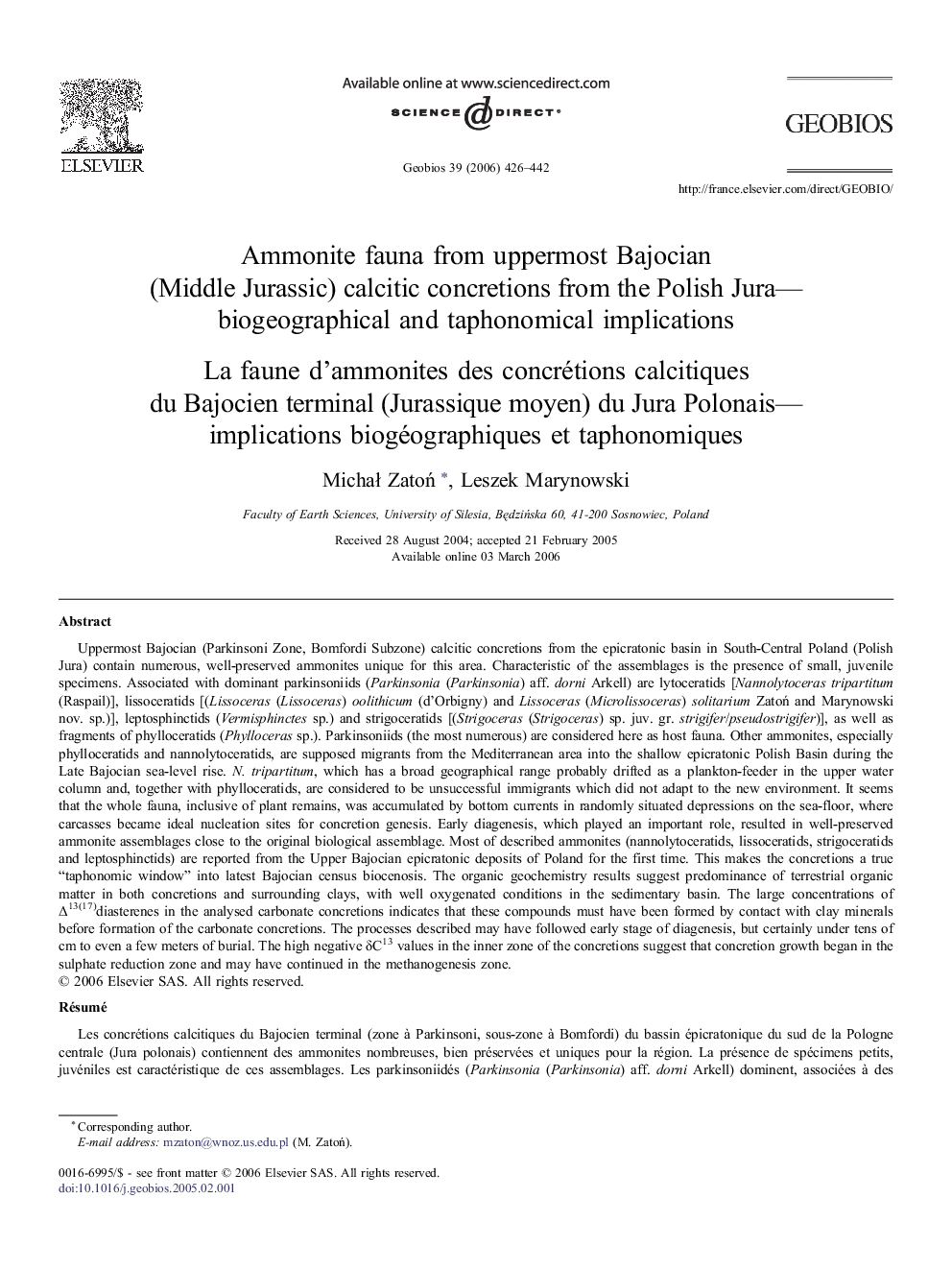| کد مقاله | کد نشریه | سال انتشار | مقاله انگلیسی | نسخه تمام متن |
|---|---|---|---|---|
| 4748668 | 1360132 | 2006 | 17 صفحه PDF | دانلود رایگان |

Uppermost Bajocian (Parkinsoni Zone, Bomfordi Subzone) calcitic concretions from the epicratonic basin in South-Central Poland (Polish Jura) contain numerous, well-preserved ammonites unique for this area. Characteristic of the assemblages is the presence of small, juvenile specimens. Associated with dominant parkinsoniids (Parkinsonia (Parkinsonia) aff. dorni Arkell) are lytoceratids [Nannolytoceras tripartitum (Raspail)], lissoceratids [(Lissoceras (Lissoceras) oolithicum (d'Orbigny) and Lissoceras (Microlissoceras) solitarium Zatoń and Marynowski nov. sp.)], leptosphinctids (Vermisphinctes sp.) and strigoceratids [(Strigoceras (Strigoceras) sp. juv. gr. strigifer/pseudostrigifer)], as well as fragments of phylloceratids (Phylloceras sp.). Parkinsoniids (the most numerous) are considered here as host fauna. Other ammonites, especially phylloceratids and nannolytoceratids, are supposed migrants from the Mediterranean area into the shallow epicratonic Polish Basin during the Late Bajocian sea-level rise. N. tripartitum, which has a broad geographical range probably drifted as a plankton-feeder in the upper water column and, together with phylloceratids, are considered to be unsuccessful immigrants which did not adapt to the new environment. It seems that the whole fauna, inclusive of plant remains, was accumulated by bottom currents in randomly situated depressions on the sea-floor, where carcasses became ideal nucleation sites for concretion genesis. Early diagenesis, which played an important role, resulted in well-preserved ammonite assemblages close to the original biological assemblage. Most of described ammonites (nannolytoceratids, lissoceratids, strigoceratids and leptosphinctids) are reported from the Upper Bajocian epicratonic deposits of Poland for the first time. This makes the concretions a true “taphonomic window” into latest Bajocian census biocenosis. The organic geochemistry results suggest predominance of terrestrial organic matter in both concretions and surrounding clays, with well oxygenated conditions in the sedimentary basin. The large concentrations of Δ13(17)diasterenes in the analysed carbonate concretions indicates that these compounds must have been formed by contact with clay minerals before formation of the carbonate concretions. The processes described may have followed early stage of diagenesis, but certainly under tens of cm to even a few meters of burial. The high negative δC13 values in the inner zone of the concretions suggest that concretion growth began in the sulphate reduction zone and may have continued in the methanogenesis zone.
RésuméLes concrétions calcitiques du Bajocien terminal (zone à Parkinsoni, sous-zone à Bomfordi) du bassin épicratonique du sud de la Pologne centrale (Jura polonais) contiennent des ammonites nombreuses, bien préservées et uniques pour la région. La présence de spécimens petits, juvéniles est caractéristique de ces assemblages. Les parkinsoniidés (Parkinsonia (Parkinsonia) aff. dorni Arkell) dominent, associées à des lytocératidés [Nannolytoceras tripartitum (Raspail)], des lissocératidés [(Lissoceras (Lissoceras) oolithicum (d'Orbigny) et Lissoceras (Microlissoceras) solitarium Zatoń et Marynowski nov. sp.)], des leptosphinctidés (Vermisphinctes sp.) et strigocératidés [(Strigoceras (Strigoceras) sp. juv. gr. strigifer/pseudostrigifer)], ainsi que des fragments de phyllocératidés (Phylloceras sp.). Très nombreuses, les parkinsoniidés sont considérées ici comme la faune hôte. D'autres ammonites, en particulier les phylloceratidés et les nannolytoceratidés, ont probablement immigré depuis le domaine Méditerranéen vers les bassins peu profonds de Pologne lors de la transgression du Bajocien supérieur. N. tripartitum, de large répartition biogéographique, en tant que planctonophage de la tranche d'eau supérieure a probablement dérivé, et avec les phyllocératidés il est considéré comme immigrant infructueux qui ne s'est pas adapté au nouvel environnement. Il semble que l'assemblage paléontologique, incluant des restes de plantes, s'est formé par accumulation dans les dépressions du fond marin, sous l'action des courants. Les cadavres ont servi de site de nucléation pour le développement de concrétions. La diagenèse précoce a joué un rôle important dans la préservation d'assemblages d'ammonites proches des associations biologiques originelles. La plupart des ammonites décrites (nannolytocératidés, lissocératidés, strigocératidés et leptosphinctidés) sont mentionnées pour la première fois pour ces dépôts épicratoniques de Pologne. Ceci fait des concrétions une véritable « fenêtre taphonomique » sur les biocénoses du Bajocien terminal. La géochimie organique suggère la prédominance de la matière organique d'origine continentale à la fois dans les concrétions et les argiles encaissantes, et des conditions plutôt euxiques dans le bassin sédimentaire. Les fortes concentrations de 13(17) diastérènes dans les concrétions carbonatées analysées indique que ces composées doivent avoir été formés au contact avec des minéraux argileux avant la formation des concrétions. Les processus décrits ont pu suivre les stades précoces de diagenèse, sous une colonne de quelques dizaines de centimètres à quelques mètres de sédiments. Les valeurs très négatives du δC13 dans la partie interne des concrétions suggèrent que leur croissance pourrait avoir été initiée dans la zone de réduction des sulfates puis avoir continué dans la zone méthanogène.
Journal: Geobios - Volume 39, Issue 3, May–June 2006, Pages 426–442